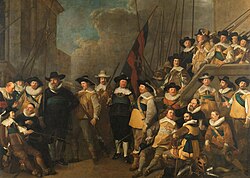Jacob Adriaensz Backer (1608 – 27 August 1651) was a Dutch Golden Age painter. He produced about 140 paintings in twenty years, including portraits, religious subjects, and mythological paintings. In his style, he was influenced by Wybrand de Geest, Rubens and Abraham Bloemaert. He is also noted for his drawings of male and female nudes.



Biography
editBacker was born in Harlingen, Netherlands, but his father moved in 1611 to Amsterdam, after his wife died. The family lived on Nieuwendijk near the harbour. Between 1627 and 1633 he and Govert Flinck, both Mennonites, were pupils of Lambert Jacobsz in Leeuwarden, a mennonite teacher, father of Abraham Lambertsz van den Tempel, painter of religious work, and after moving to Amsterdam, a neighbor. In 1633 Backer returned to Amsterdam, and probably worked for Hendrick Uylenburgh. Backer never married, never bought a house, and might have lived with his brother or nephew Adriaen Backer, who also became a portrait painter. He died in Amsterdam, in his early forties.
Work
editHis extreme quickness in painting portraits has been particularly noticed, and Joachim von Sandrart wrote in his Teutsche Academie that a woman came from Haarlem and went home the same day, in which short period of time her portrait, cuffs, fur, collar, together with the rest of her dress and both hands, was handsomely completed in a life-sized half-length.[1][2][3] This remark refers both to the success of the wet-on-wet technique practised in the Netherlands at that time, as well as the fact that the trekschuit, which was a new invention in 1632, allowed regular comfortable transport between Haarlem and Amsterdam and made such trips to portrait painters possible.
Besides being an important portrait painter—some 70 portraits can be attributed to him with certainty—Backer was an excellent painter of religious and mythological paintings. He was especially interested in pastoral subjects, themes from contemporary history, like Granida and Daifilo, and the huge Crowning of Mirtillo from 1641 in the Brukenthal National Museum in Sibiu (250 x 250 cm.). The painting with the schutterij, Company of Cornelis de Graeff, for years on the same wall as Rembrandt's Night Watch, is in the Rijksmuseum. Backer, who joined Rembrandt's studio between 1632 and 1634,[4] was one of the most independent of his pupils[5] although absorbed the spirit of Rembrand's style[6] which is reflected in his Portrait of a Woman (Saskia van Uylenburgh?) in the National Museum in Warsaw (c. 1633). The artist excelled in painting hands and feet. He never painted a town or landscape. He was a leading artist in Amsterdam until his premature death in 1651. He was buried in the Noorderkerk.
A major exhibition of Jacob Backer's work was displayed at the Rembrandthuis from 29 November 2008 to 22 February 2009.
Selected works
edit- Portrait of a Woman (Saskia van Uylenburgh?), c. 1633, National Museum, Warsaw
- Granida and Daifilo, c. 1635, Hermitage Museum, St. Petersburg
- Portrait of a Young Woman, c. 1638, Los Angeles County Museum of Art, Los Angeles
- Courtesan, 1640, National Museum of Ancient Art, Lisbon
- Crowning of Mirtillo, 1641, Brukenthal National Museum, Sibiu, Romania
- Company of Cornelis de Graeff, 1642, Rijksmuseum, Amsterdam
- Diana With Her Nymphs, 1649, Hermitage Museum, St. Petersburg
- Portrait of A Lady, Nelson-Atkins Art Museum, Kansas City, Missouri
- The Angel Appearing to the Centurion Cornelius, c. 1630, Indiana University Art Museum, Bloomington, Indiana
- Portrait of Young Women, Regional gallery of Liberec, Czech Republic
References
edit- ^ Quote from Backer biography in the Teutsche Academie
- ^ He completely finished, in one day, the half length portrait of a lady in full dress, even so early, that she was able to return the same day back to Haarlem with the painting; cited 50 years later in (in Dutch) Jakob Bakker biography in De groote schouburgh der Nederlantsche konstschilders en schilderessen (1718) by Arnold Houbraken, courtesy of the Digital library for Dutch literature
- ^ Rose, Hugh James (1857). "Bakker, James". A New General Biographical Dictionary. Vol. 3 BAH–BEE. London: B. Fellowes et al. p. 45.
- ^ William Rockhill Nelson Gallery of Art and Mary Atkins Museum of Fine Arts (1965). Drawings: collection of Milton McGreevy. Archetype Publications. p. 23.
From 1632 to 1634, he studied with Rembrandt
- ^ Christopher Wright (1992). The world's master paintings. Routledge. p. 298. ISBN 9780415022408.
Backer was one of the most independent pupils of Rembrandt
- ^ Paul Huys Janssen, Werner Sumowski (1992). The Hoogsteder Exhibition of Rembrandt's Academy. Hoogsteder & Hoogsteder. p. 89.
Backer proved susceptible to Rembrandt's style for, as the leading artist, he was all the rage.
- Peter van den Brink et al. (2008) Jacob Backer (1608/9-1651).
- Walter Liedtke (2007) Dutch paintings in the Metropolitan Museum of Art.